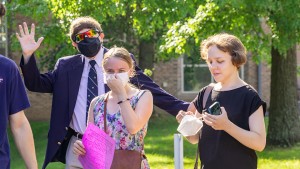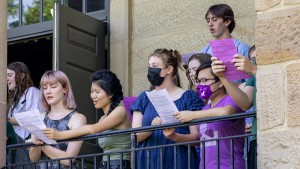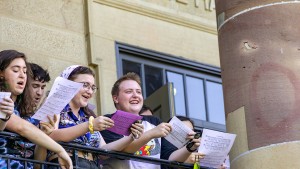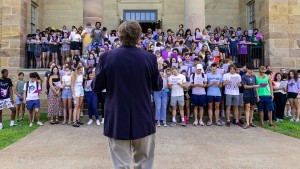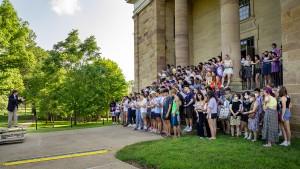A few days ago, I think I came the closest I will ever come to feeling the presence of a ghost. I am a fervent nonbeliever in all things supernatural, but I made an exception when I had the pleasure of participating in one of Kenyon’s most famous traditions: First-Year Sing. For this tradition, new students stand before all of us upperclassmen on the front steps of Rosse Hall and sing four iconic Kenyon songs while we subject them to relentless jeering and heckling (all in good fun, of course). There was an indescribable electricity buzzing in the community as we shouted and laughed together.
Because we sophomores never had a First-Year Sing due to the pandemic, our class was invited to experience Kenyon’s first-ever Sophomore Sing. It was strange to finally be on the receiving end of it all (with the first-years giving us some of our own medicine with tasteful “boos” when we sang out of tune), but I felt like it completed a part of my Kenyon experience that had previously been missing. That kind of tough-love welcome into the community was a rite of passage, and it embraced us with open arms. It was the welcome home hug we’d been missing.
The songs, to my surprise, though very much filled with pride and heartfelt appreciation for “our dear old Kenyon,” also were filled with risque jokes and questionable retellings of Kenyon’s history. It made me rethink my perception of the students who wrote them all those years ago. I often find myself picturing their era only in the faded blacks and whites through which they captured it. But those students were just as lively and real as we are, and one could almost feel their voices joining our own in front of Rosse.
The truth is, they got as much pleasure out of laughing at naughty humor and poking fun at first-year students as we do today. It says something about the universality of adolescence and adolescent humor.
However, it’s worth noting that these traditions date back to a time when Kenyon wasn’t what it is today. It has become a significantly more diverse place and encompasses points of view the past often failed to consider, and that adds nuance to these traditions. At the same time, new traditions continue to be created while old traditions are changed to accommodate Kenyon’s, and the world’s, changing climate. Just this year, one of the traditional First-Year Sing songs, “Ninety-Nine,” was replaced with "Stand Up and Cheer," another classic song which is, as the song’s subtitle describes it on the music sheets, “a commemoration of Kenyon’s last victory over Ohio State in football.” (In the words of Doc Locke, the conductor for First-Year Sing, “Needless to say, that song is very old.”)
Though both songs are pre-1900 traditional Kenyon songs, I am optimistic that this change is a demonstration that Kenyon’s traditions are malleable. While the fact that something may or may not be universally enjoyable does not necessarily mean it’s wrong to enjoy it, I hope that the future holds traditions which can better include this more diverse Kenyon in its shenanigans. And as Kenyon continues to sway in the direction of immense inclusivity and diversity, my gut tells me that that future is not far off. Traditions shift, and I look forward to seeing how Kenyon’s continue to evolve to include all the points of view this school has come to include in its classrooms.
There is a lot that makes Kenyon a lovely place to be, but I like to think that these sorts of traditions help make up the lifeblood that keeps this community together.


